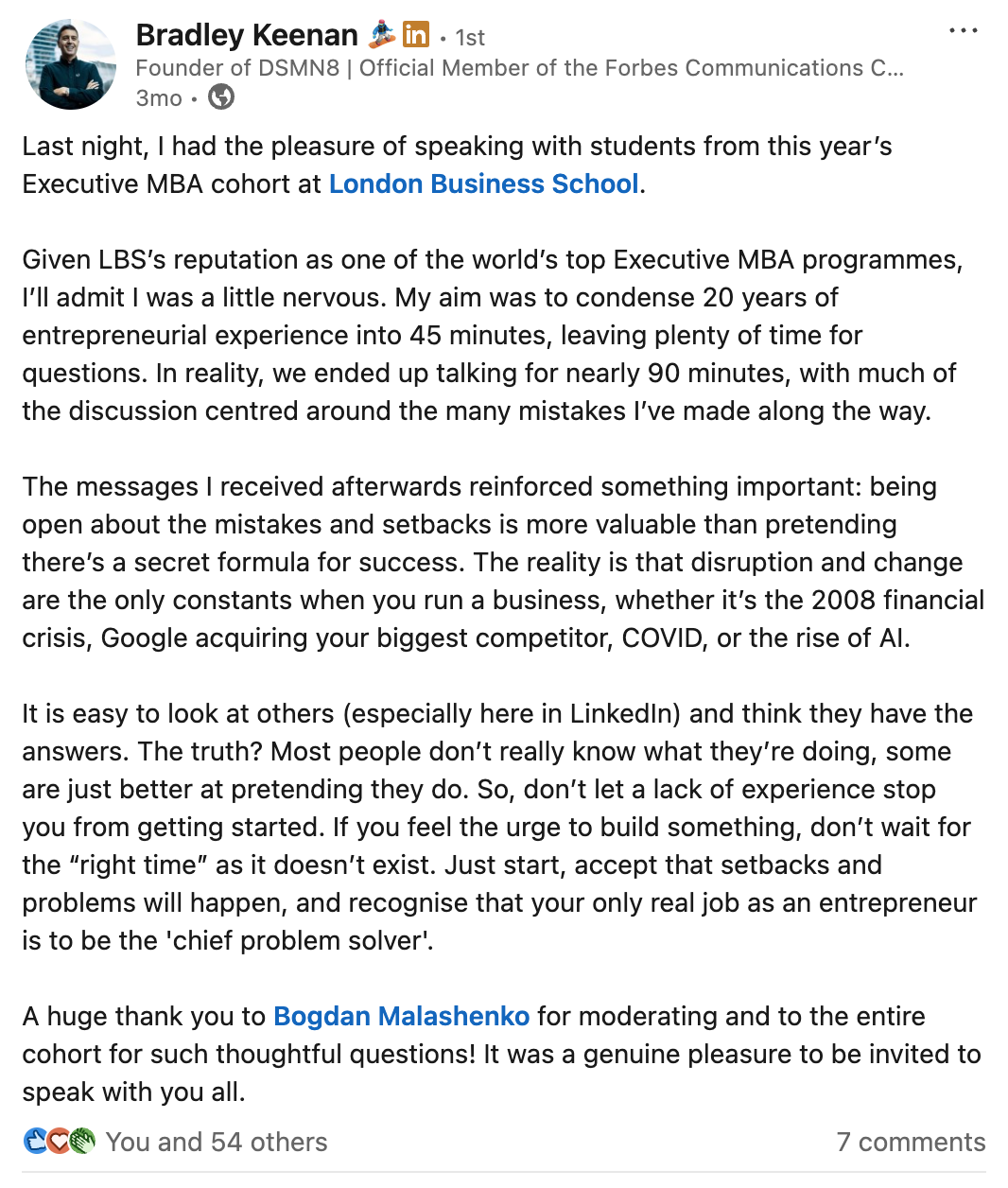
Change is a constant in business, but that doesn’t make it any easier to navigate. Whether you’re managing a restructuring, rebranding, or simply facing tough market conditions, it’s natural for employee engagement to take a hit.
But here’s the good news: instead of pausing, your employee advocacy program can become a powerful initiative to help reconnect your teams, rebuild morale, and remind everyone what makes your culture worth championing.
Why Employee Advocacy Still Matters During Times of Change
When sentiment is low, advocacy might feel like a “nice-to-have” rather than an essential. But that mindset misses the real opportunity: in difficult moments, authentic advocacy can reinforce trust, highlight team resilience, and give employees a reason to feel proud 💪
And when participation is voluntary, storytelling is genuine, and leadership sets the tone, advocacy becomes less about pushing content and more about pulling people together.
7 Smart Ways to Strengthen Advocacy During Uncertainty
These seven tactics come straight from DSMN8’s customer success team, based on real-world experience guiding clients through change. They’re built to move advocacy beyond content sharing and drive genuine, confident employee engagement.
1. Reframe the Purpose: Focus on Storytelling, Not Promotion
Shift the focus from brand amplification to shared experiences. Encourage employees to share personal wins, project milestones, or positive moments that reflect the genuine heartbeat of your company.
When people feel emotionally connected, they are more likely to engage in a genuine and impactful way, both within the company and across their networks.
💡 Content idea: Ask employees to “share something that made you smile this week” or highlight a colleague’s great work. It’s light, human, and highly engaging.
2. Empower Trusted Voices to Lead the Way
Every business has its internal champions, the individuals who remain positive, connected, and engaged even when times are tough.
Identify these individuals and support them with exclusive content, sneak peeks, or opportunities to co-create posts.
They’ll set the tone for others and maintain energy levels across the wider team.
Use our ideal advocate profiles worksheet and pyramid of employee influence to help find these champions!
3. Keep It Light, Keep It Human
Now isn’t the time for over-polished press releases or overly branded posts.
Streamline your content calendar to include real, relatable updates, such as employee shoutouts, behind-the-scenes moments, leadership thank-yous, or “day in the life” content.
An employee brand channel takeover (like ours pictured above) is a great way to reinforce company values and show your team that you support them.
💡 Content idea: Send a quick Slack message to team leaders asking, “Who deserves a shoutout this week?” and then turn that into advocacy content.
For more on the types of content you need for a successful advocacy program, check out the podcast episode below:
4. Leadership as Culture Builders
The 2025 Employee Advocacy Benchmark Report found that 73% of program managers see leadership involvement as their top priority, and for good reason.
Our analysis of over 11,000 LinkedIn posts showed that CEOs can generate the same levels of engagement as company pages, even with 98% fewer followers.
It’s not just about numbers; it’s about real influence.
Employees look to leaders for stability and direction during uncertainty, making their visible advocacy more impactful than ever.
When senior leaders show up as people, not just executives, it creates a ripple effect throughout the organization. Their visibility and openness help rebuild trust, promote transparency, and give employees the confidence to engage.
Encourage leaders to share personal reflections, team wins, or messages of appreciation.
And if they’re short on time, our CEO Content Framework makes it easy to support their presence on LinkedIn without adding to their workload 🙌
5. Encourage Personal Expression
Not every post needs to be work-related.
In fact, some of the most powerful advocacy comes when employees feel free to celebrate what matters to them.
A colleague’s success, a cause they care about, or a personal achievement can all build authenticity, boost engagement, and foster a values-driven culture.
Our CEO, Bradley Keenan, leads by example, sharing his own career and personal development achievements, such as speaking with MBA students at London Business School.
For more on the types of content you need for a successful advocacy program, check out the podcast episode below:
6. Measure Sentiment, Not Just Metrics
Platform analytics are important, but numbers don’t tell the whole story.
Consider running a short, anonymous pulse survey to check how people feel about advocacy and culture overall.
Ask what’s holding them back, what content they’d like to see more of, and what would motivate them to participate. Use DSMN8’s internal polls feature to quickly find out what content your advocates would like more of.
Then act on the feedback. Your program should feel like a community, so it’s essential to make sure advocate voices are heard.
💡 Top tip: Use our Employee Advocacy Feedback Survey Template to easily gather employee thoughts.
7. Recognize the Wins
Acknowledgement goes a long way, especially in challenging times.
Celebrate advocates through newsletters or internal communications channels, and use DSMN8’s built-in leaderboards and reward features.
Whether it’s a top performer or someone who’s simply showing up and sharing consistently, small moments of recognition can make a big impact. Even a quick “thank you” lets people know their voice matters.
💡 Pro tip: Recognition doesn’t need to be tied to results. Highlight creativity, consistency, or even someone’s first post. It all contributes to momentum!
The External Impact: Why Advocacy Shapes Perception Beyond the Business
When your advocacy program reflects a positive company culture, its influence goes far beyond the walls of your company.
When employees consistently demonstrate honesty, integrity, and optimism, it sends a clear signal to the outside world: this is a brand with heart, resilience, and integrity.
During times of change, your brand’s credibility is under more scrutiny than ever. Prospective clients, candidates, investors, and even current customers are watching for signs of stability, alignment, and culture.
And nothing builds trust faster than real people sharing real experiences 💪
When employees post stories, team wins, and leadership moments, it helps to:
- Reassure customers that the business is focused and aligned.
- Reinforce internal culture by spotlighting shared values and resilience.
- Strengthen brand equity by demonstrating values in action.
Remember, your people are the bridge between your brand and the outside world.
Final Thought: Advocacy is a Culture Catalyst
Employee advocacy isn’t just a marketing and sales tool; it’s a culture amplifier.
During times of change, it offers a much-needed reminder of what your company stands for and who’s standing behind it.
By keeping it human, thoughtful, and authentic, advocacy can help your people feel more connected and valued.
So, if your team is feeling the weight of uncertainty, consider this your sign not to hit pause. Instead, reframe, refocus, and use employee advocacy as a force for reconnection and resilience.
Additional Resources
- Employee Advocacy Training Plan – A practical guide to training employees for advocacy success, especially important when aligning teams during transitions or mergers.
- The Best Content Strategy for Employee Advocacy. This podcast episode explores the most important content types to maintain employee engagement and will be particularly valuable during organisational shifts.
- The Pyramid of Employee Influence. A framework to nurture advocacy from the ground up, this one is useful to keep in mind when re-establishing trust and momentum.
Emily Neal
SEO and Content Specialist at DSMN8. Emily has 10 years experience blogging, and is a pro at Pinterest Marketing, reaching 1 million monthly views. She’s all about empowering employees to grow their personal brands and become influencers.








